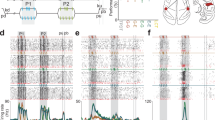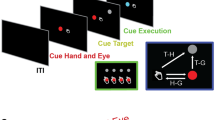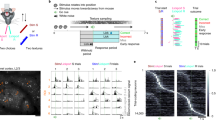Abstract
The ability to discriminate between two sequential stimuli requires evaluation of current sensory information in reference to stored information. Where and how does this evaluation occur? We trained monkeys to compare two mechanical vibrations applied sequentially to the fingertips and to report which of the two had the higher frequency. We recorded single neurons in secondary somatosensory cortex (S2) while the monkeys performed the task. During the first stimulus period, the firing rate of S2 neurons encoded the stimulus frequency. During the second stimulus period, however, some S2 neurons did not merely encode the stimulus frequency. The responses of these neurons were a function of both the remembered (first) and current (second) stimulus. Moreover, a few hundred milliseconds after the presentation of the second stimulus, these responses were correlated with the monkey's decision. This suggests that some S2 neurons may combine past and present sensory information for decision-making.
This is a preview of subscription content, access via your institution
Access options
Subscribe to this journal
Receive 12 print issues and online access
$209.00 per year
only $17.42 per issue
Buy this article
- Purchase on Springer Link
- Instant access to full article PDF
Prices may be subject to local taxes which are calculated during checkout







Similar content being viewed by others
References
Mountcastle, V.B., Steinmetz, M.A. & Romo, R. Frequency discrimination in the sense of flutter: psychophysical measurements correlated with postcentral events in behaving monkeys. J. Neurosci. 10, 3032–3044 (1990).
Hernández, A., Salinas, E., García, R. & Romo, R. Discrimination in the sense of flutter: new psychophysical measurements in monkeys. J. Neurosci. 17, 6391–6400 (1997).
Horwitz, G.D. & Newsome, W.T. Target selection for saccadic eye movements: direction-selective visual responses in the superior colliculus. J. Neurophysiol. 86, 2527–2542 (2001).
Kim, J.N. & Shadlen, M.N. Neural correlates of a decision in the dorsolateral prefrontal cortex of the macaque. Nat. Neurosci. 2, 176–185 (1999).
Platt, M.L. & Glimcher, P.W. Neural correlates of decision variables in parietal cortex. Nature 400, 233–238 (1999).
Shadlen, M.N. & Newsome, W.T. Neural basis of a perceptual decision in the parietal cortex (area LIP) of the rhesus monkey. J. Neurophysiol. 86, 1916–1936 (2001).
Schall, J.D. Neural basis of deciding, choosing and acting. Nat. Rev. Neurosci. 1, 33–42 (2001).
Salinas, E., Hernández, A., Zainos, A. & Romo, R. Periodicity and firing rate as candidate neural codes for the frequency of vibrotactile stimuli. J. Neurosci. 20, 5503–5515 (2000).
Hernández, A., Zainos, A. & Romo, R. Neuronal correlates of sensory discrimination in the somatosensory cortex. Proc. Natl. Acad. Sci. USA 97, 6191–6196 (2000).
Romo, R., Hernández, A., Zainos, A. & Salinas, E. Somatosensory discrimination based on cortical microstimulation. Nature 392, 387–390 (1998).
Romo, R., Hernández, A., Zainos, A., Brody, C.D. & Lemus, L. Sensing without touching: psychophysical performance based on cortical microstimulation. Neuron 26, 273–278 (2000).
Romo, R., Brody, C.D., Hernández, A. & Lemus, L. Neuronal correlates of parametric working memory in the prefrontal cortex. Nature 399, 470–473 (1999).
Hernández, A., Zainos, A. & Romo, R. Temporal evolution of a decision-making process in medial premotor cortex. Neuron 33, 959–972 (2002).
Godschalk, M., Lemon, R.N., Kuypers, H.G. & Ronday, H.K. Cortical afferents and efferents of monkey postarcuate area: an anatomical and electrophysiological study. Exp. Brain Res. 56, 410–424 (1984).
Leichnetz, G.R. Afferent and efferent connections of the dorsolateral precentral gyrus (area 4, hand/arm region) in the macaque monkey, with comparisons to area 8. J. Comp. Neurol. 254, 460–492 (1986).
Preuss, T.M. & Goldman-Rakic, P.S. Connections of the ventral granular frontal cortex of macaques with perisylvian premotor and somatosensory areas: anatomical evidence for somatic representation in primate frontal association cortex. J. Comp. Neurol. 282, 293–316 (1989).
Cavada, C. & Goldman-Rakic, P.S. Posterior parietal cortex in rhesus monkey: I. Parcellation of areas based on distinctive limbic and sensory corticocortical connections. J. Comp. Neurol. 287, 393–421 (1989).
Felleman, D.J. & Van Essen, D.C. Distributed hierarchical processing in the primate cerebral cortex. Cereb. Cortex 1, 1–47 (1991).
Tokuno, H. & Tanji, J. Input organization of distal and proximal forelimb areas in the monkey primary motor cortex: a retrograde double labeling study. J. Comp. Neurol. 333, 199–209 (1993).
Luppino, G., Mattelli, M., Camarda, R.M. & Rizzolatti, G. Cortico-cortical connections of area F3 (SMA-proper) and area F6 (pre-SMA) in the macaque monkey. J. Comp. Neurol. 338, 114–140 (1993).
Carmichael, S.T. & Price, J.L. Sensory and premotor connections of the orbital and medial prefrontal cortex of macaque monkeys. J. Comp. Neurol. 363, 642–664 (1995).
Burton, H. & Sinclair, R.J. in Pain and Touch (ed. Kruger, L.) 105–177 (Academic, San Diego, California, 1996).
Cippolloni, P.B. & Pandya, D.N. Cortical connections of the frontoparietal opercular areas in the rhesus monkey. J. Comp. Neurol. 403, 431–458 (1999).
Jiang, W., Tremblay, F. & Chapman, C.E. Neuronal encoding of texture changes in the primary and the secondary somatosensory cortical areas of monkeys during passive texture discrimination. J. Neurophyisol. 77, 1656–1662 (1997).
Pruett, J.R., Sinclair, R.J. & Burton, H. Neural correlates for roughness choice in monkey second somatosensory cortex (SII). J. Neurophysiol. 86, 2069–2080 (2001).
Sinclair, R.J. & Burton, H. Neuronal activity in the second somatosensory cortex of monkeys (Macaca mulatta) during active touch of gratings. J. Neurophysiol. 70, 331–350 (1993).
Hsiao, S.S., O'Shaughnessy, D.M. & Johnson, K.O. Effects of selective attention on spatial form processing in monkey primary and secondary somatosensory cortex. J. Neurophysiol. 70, 444–447 (1993).
Mishkin, M. Analogous neural models for tactual and visual learning. Neuropsychologia 17, 139–151 (1979).
Murray, E.A. & Mishkin, M. Relative contributions of SII and area 5 to tactile discrimination in monkeys. Behav. Brain Res. 11, 67–83 (1984).
Miller, E.K., Li, L. & Desimone, R. Activity of neurons in anterior inferior temporal cortex during a short-term memory task. J. Neurosci. 13, 1460–1478 (1993).
Siegel, S. & Castellan, N.J. Nonparametric Statistics for Behavioral Sciences (McGraw-Hill, New York, 1988).
Draper, N. & Smith, H. Applied Regression Analysis 2nd edn. (Wiley, New York, 1966).
Press, W., Teukolsky, S.A., Vettering, W.T. & Fannery, B.P. Numerical Recipes in C 2nd edn. (Cambridge Univ. Press, Cambridge, U.K., 1992).
Britten, K.H., Newsome, W.T., Shadlen, M.N., Celebrini, S. & Movshon, J.A. A relationship between behavioral choice and the visual responses in macaque MT. Vis. Neurosci. 13, 87–100 (1996).
Dodd, J.V., Krug, K., Cumming, B.G. & Parker, A.J. Perceptually bistable three-dimensional figures evoke high choice probabilities in cortical area MT. J. Neurosci. 21, 4809–4821 (2001).
Ro, J.Y., Debowy, D., Ghosh, S. & Gardner, E.P. Depression of neuronal firing rates in somatosensory and posterior parietal cortex during object acquisition in a prehension task. Exp. Brain Res. 135, 1–11 (2000).
Chapman, C.E. Active versus passive touch: factors influencing the transmission of somatosensory signals to primary somatosensory cortex. Can. J. Physiol. Pharm. 72, 558–570 (1994).
Chapman, C.E., Jiang, W. & Lamarre, Y. Modulation of lemniscal input during conditioned arm movements in the monkey. Exp. Brain Res. 72, 316–334 (1988).
Tomita, H., Ohbayashi, M., Nakahara, K., Hasegawa, I. & Miyashita, Y. Top-down signal from prefrontal cortex in executive control of memory retrieval. Nature 401, 699–703 (1999).
Johnson, K.O. Sensory discrimination: neural processes preceding discrimination decision. J. Neurophysiol. 43, 1793–1815 (1980).
Acknowledgements
We thank W.T. Newsome for comments and discussions. R.R.'s research was partially supported by an International Research Scholars Award from the Howard Hughes Medical Institute and grants from Millenium Science Initiative-CONACT and DGAPA-UNAM. R.R. led the experiments and carried them out together with A.H., A.Z. and L.L.; C.B. and A.H. designed and carried out the data analysis; C.B. and R.R. co-wrote the paper.
Author information
Authors and Affiliations
Corresponding author
Ethics declarations
Competing interests
The authors declare no competing financial interests.
Supplementary information
Rights and permissions
About this article
Cite this article
Romo, R., Hernández, A., Zainos, A. et al. Neuronal correlates of decision-making in secondary somatosensory cortex. Nat Neurosci 5, 1217–1225 (2002). https://doi.org/10.1038/nn950
Received:
Accepted:
Published:
Issue Date:
DOI: https://doi.org/10.1038/nn950
This article is cited by
-
Behaviorally relevant decision coding in primary somatosensory cortex neurons
Nature Neuroscience (2022)
-
A continuum of invariant sensory and behavioral-context perceptual coding in secondary somatosensory cortex
Nature Communications (2021)
-
Tactile spatial discrimination on the torso using vibrotactile and force stimulation
Experimental Brain Research (2021)
-
Prefrontal cortex exhibits multidimensional dynamic encoding during decision-making
Nature Neuroscience (2020)
-
Human stereoEEG recordings reveal network dynamics of decision-making in a rule-switching task
Nature Communications (2020)



